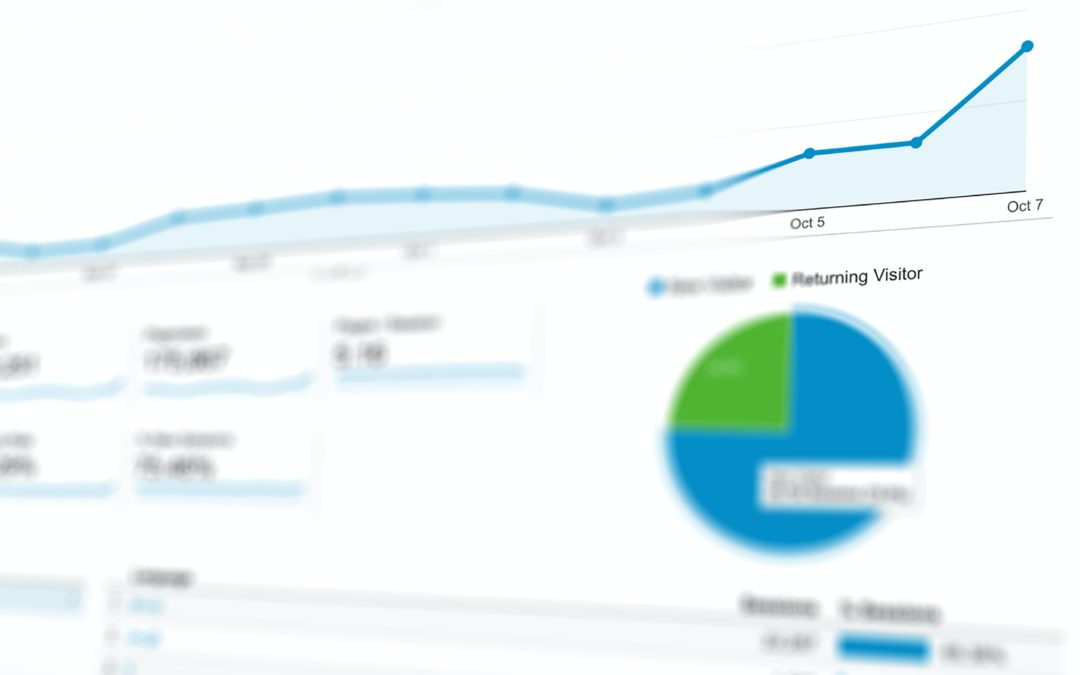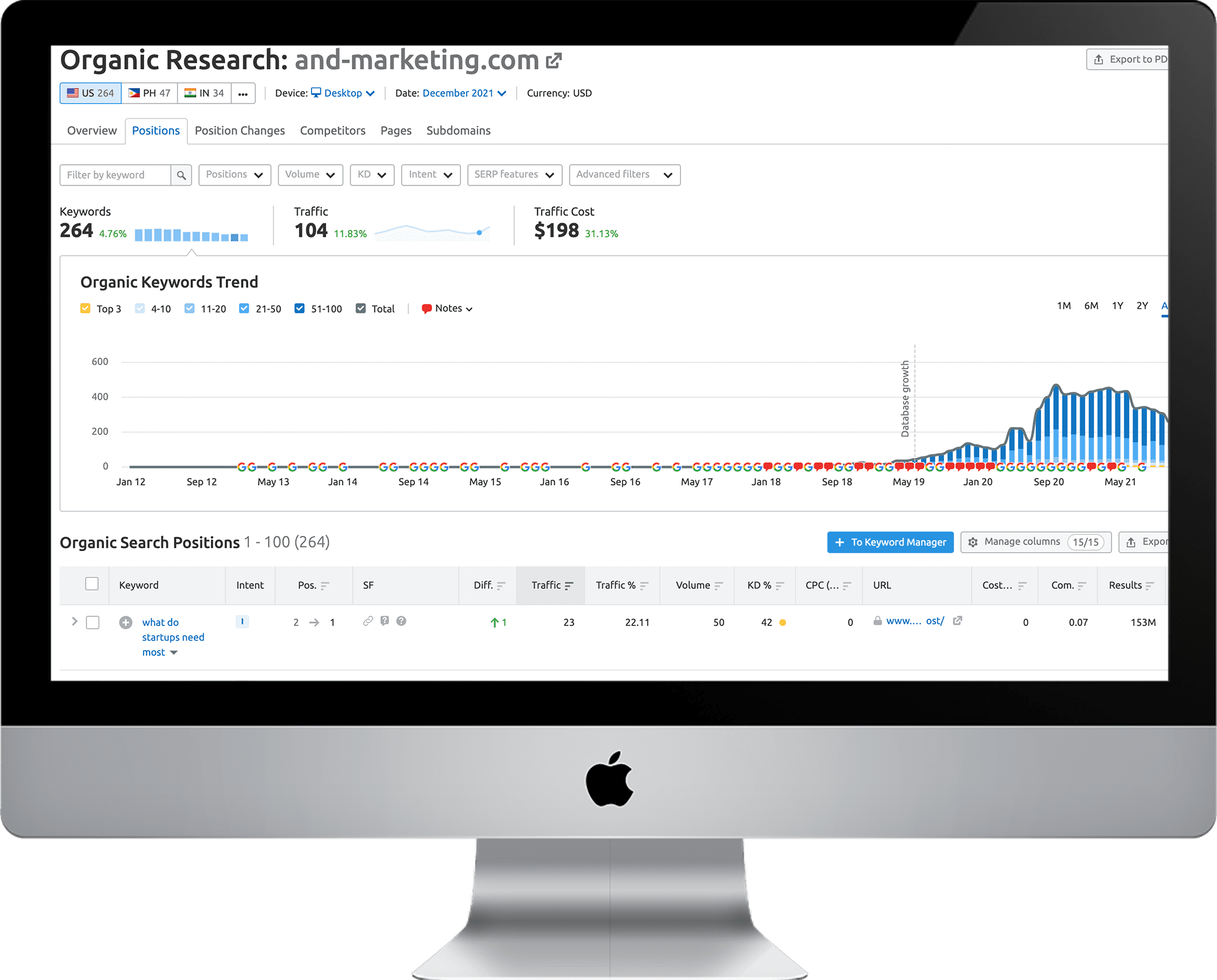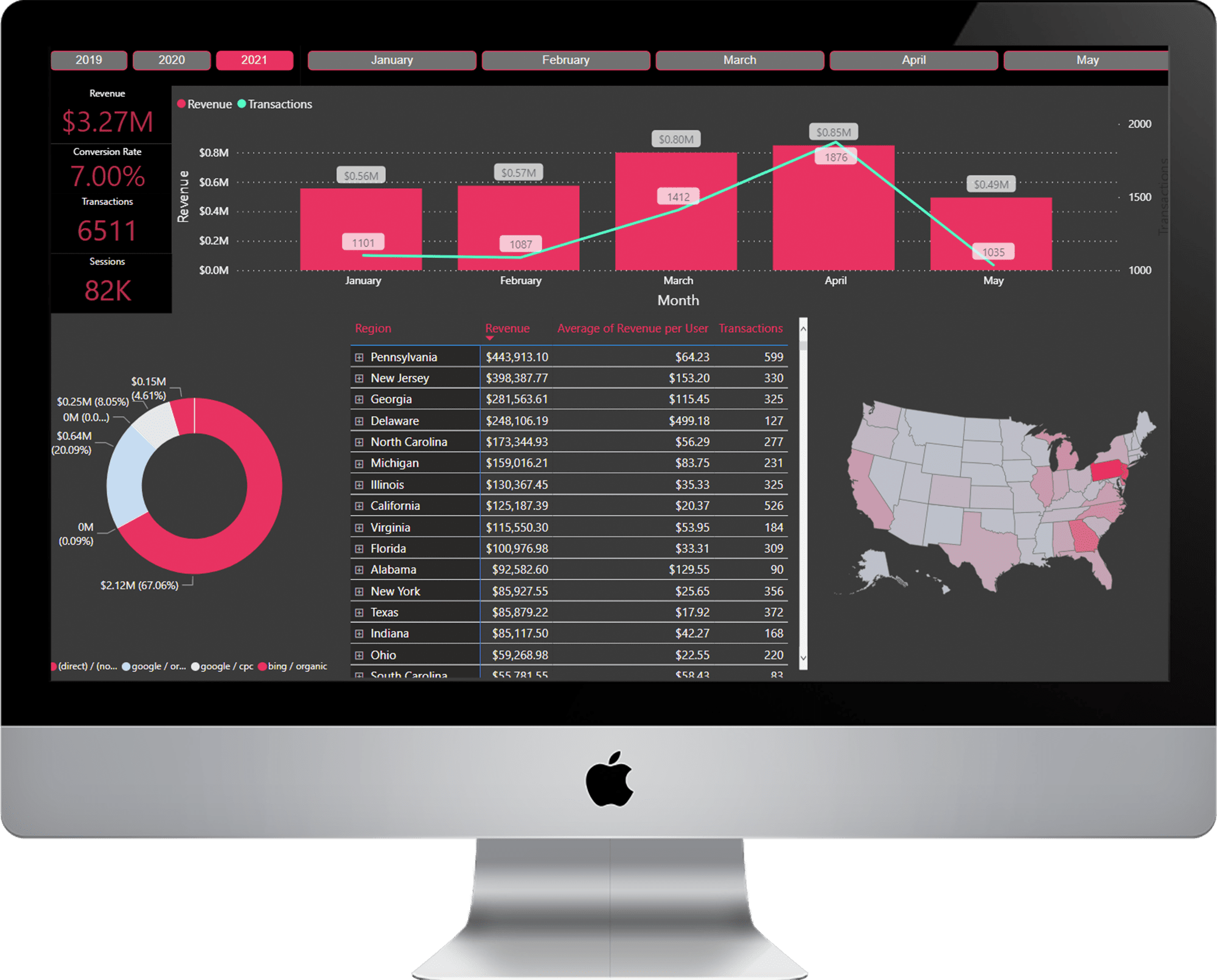All of the marketing trends with none of the industry jargon.
Sign up for our newsletter to stay updated on best practices, actionable tips, and virtual events so you can grow your business like a marketing pro.
"*" indicates required fields


For most companies, LinkedIn is the most important social channel for their overall awareness and lead generation efforts. Yet so many organizations (we’re even guilty sometimes) just blindly post without knowing when they can best reach their audience. “When is the best day to post on LinkedIn to ensure my audience sees and engages with my awesome content?” is an age-old question and has layers to it.
But the good news is, we now have access to data that can help us answer that question. So, when is the best time to post on LinkedIn?
Well, the TLDR version of the answer is – it varies based on your audience. However, we at &Marketing don’t particularly love that answer. We also like to dig a little bit deeper and have some fun by leaning into data and building fun dashboards. So when we were posed this question, we decided to create something new that could give us an answer and potentially add to our Business Intelligence services. Here’s what we did and learned.
While you might generate some leads and back into your business goals with this approach, you’ll likely just be wasting time and money when you could be working smarter, not harder.
However, with all of the tools and data out there, it can be overwhelming or down right impossible to even know where to begin and how to leverage all of these glorious resources. Therefore, we’re going to help you find the elusive needle in the hay sack and show you three tools &Marketing leverages to save time, stop guessing, and still generate big results for our clients (and ourselves).
We gathered three years of LinkedIn data from a combination of sources.
Taking all of this data, we built several dashboards via Microsoft Power B.I. to help us mine through the 500+ LinkedIn posts and the thousands of website sessions from LinkedIn. These dashboards helped us easily uncover insights that could apply to our business questions.
Pro Tip: Do NOT use Bitly links with your LinkedIn posts. It makes it harder to match up the data with your Analytics.
After sifting through 500+ posts and all of our LinkedIn analytics data, here is what we uncovered:
We’d be silly to look at all of this data and just say, “we’re doing great!” We now have actionable insights that will help us optimize our organic LinkedIn strategy. What can we do based on the above is:
1. Our audience is most engaged with our LinkedIn content and engagement with our site.
2. Have the best conversion rates on our site.
As we mentioned in the beginning, everyone’s audience and social presence is different, so this data may be vastly different than what you uncover. The important takeaway is that all of this data is FREE and available to you via LinkedIn and your Google Analytics. When thinking about and crafting your organic social strategy, don’t neglect these valuable insights. Lean on them to make your LinkedIn presence felt by the most people. Don’t waste your valuable time just posting randomly without actually figuring out what works.
Want &Marketing to perform a free analysis of your LinkedIn? Contact us today!
Marketing Director Paul Ferguson helps clients develop fully integrated marketing solutions that make impressions and drive results. Whether it be design-oriented campaigns or digital market execution, Paul skillfully creates strategies to effectively reach client’s desired audiences. Follow Paul on LinkedIn.
&Marketing provides the robust outsourced marketing department growing companies need without the high overhead costs of big agencies or full-time employees. Our variable model empowers businesses to reach their growth goals through access to the guidance and expertise of senior level strategists and a flexible execution team.
Are you facing challenges of your own in generating leads and meeting your business’ growth goals?
We’d love to learn more about your challenges and how a coordinated marketing approach might help take your organization to the next level.


Now more than ever, marketers have a wealth of tools and data designed to help us not only understand our audience better, but uncover where that audience is living online and what they are actively searching for. This knowledge is vital for marketing strategies designed to meet overall business goals.
Yet, with all this information on-hand and all the tools available to mine that data, many companies today are just revising marketing efforts made popular in the late ‘90s and early ‘00s; which relied on broadly plastering your message or creative assets to as many people as possible and see what sticks.
While you might generate some leads and back into your business goals with this approach, you’ll likely just be wasting time and money when you could be working smarter, not harder.
However, with all of the tools and data out there, it can be overwhelming or down right impossible to even know where to begin and how to leverage all of these glorious resources. Therefore, we’re going to help you find the elusive needle in the hay sack and show you three tools &Marketing leverages to save time, stop guessing, and still generate big results for our clients (and ourselves).
What is it?: Get measurable results from online marketing. Do SEO, content marketing, competitor research, PPC and social media marketing from just one platform. Data is good. Strategy is better. SEMRush gives you both. SEMRush knows a lot about your market and website. It gives you access to the world’s largest database of 20 billion keywords, 310 million ads, and 17 billion URLs crawled per day (“crawled” is a little jargon that means discovering and indexing content) .
But you get more than just numbers. SEMRush analyzes the data for you and gives you instant recommendations on SEO, content marketing and advertising that can help you improve your online visibility in days.
What it’s good for: SEMRush is great for obtaining a full listing of organic keywords that you and your competitors rank for, as well as an idea of how much traffic those terms bring to your site. SEMRush also breaks down competitors’ PPC efforts and acquisition sources. Additionally, SEMRush has recently rolled out a new feature that breaks down keyword intent, which will help you understand the gaps in your content. Lastly, SEMRush does a great job of auditing your website to identify SEO errors and challenges.
How we use it: &Marketing uses SEMRush to back up our organic data, analyze competitors organic and paid search presence research, as well as technical SEO website audits.

An example of a SEMRush Search
What is it?: Google SERP (Search Engine Results Page) tracking for anyone! With large-scale rank tracking and SERP analytics, you’re always the first with the answer to what’s happening on the SERPs. Not only will you be able to generate and monitor organic results, you’ll be able to uncover unknown competitors, content topics, related terms, and more!
What it’s good for: GetStat, founded by Moz, is an excellent tool to track keywords you currently rank for and to generate high level insights on the domains that are ranking for them and all of their related searches…at scale. Imagine having to look up 100 keywords and determining how many related searches there are for each one, how many questions people are asking about each one, and what the top 20 domains that are ranking for each one. GetStat gives you all of that data at scale.
How we use it: GetStat is a great tool to track and monitor keywords we’re looking to target. Additionally, GetStat allows us to generate reports, at scale, of the Top 20 listings, all of the People Also Ask questions (that little box on the first page of Google that tells you what else people are asking about a search query), all of the related searches, and all of the SERP features for ALL tracked keywords.

An example of a Top 20 Dashboard report from GetStat
What is it?: Audience Research. Solved. Forget expensive surveys or inaccurate, manual research. SparkToro finds the websites your customers visit, social accounts they follow, hashtags they use, and more — so you can actually get to know your target audience and do marketing that works.
Over 1,100 marketing agencies, content teams, PR leaders, and market researchers use SparkToro.
What it’s good for: SparkToro is an excellent resource for audience research. Simply type in a phrase that users have in their profile or commonly use, or a website they frequently visit. Then you’re able to uncover demographic information about people who fit that profile, websites they visit, podcasts they listen to, social accounts they follow, and press accounts they trust.
How we use it: We use SparkToro for audience research on our key decision makers. This tool helps us find commonalities in demographics and information consumption across multiple decision makers and helps us form strategies to best reach those audiences.

An example of a SparkToro Search
These are just a few of the tools we use when we perform a comprehensive Business Intelligence project. The best thing about these tools is that they allow us to export data that can be aligned with one another in data visualization programs like Power BI or Tableau. Once we have all of our data, we can develop dashboards within Power BI or Tableau, that allow us to easily navigate it and help us uncover powerful insights. No more messy excel files and pivot tables and VLookUps. Just clean, easy to read dashboards with data sets that can interact with one another and be easily mined. These insights inform the creation of a successful marketing roadmap so we know the exact steps to take to help our unique clients reach their business goals.

Example of an eCommerce Dashboard
Interested in learning more about our Business Intelligence and Analytics practice and how it can help drive your business and marketing strategy? Check out our Business Intelligence eBook to understand how this powerful process can grow your business.
Marketing Director Paul Ferguson helps clients develop fully integrated marketing solutions that make impressions and drive results. Whether it be design-oriented campaigns or digital market execution, Paul skillfully creates strategies to effectively reach client’s desired audiences. Follow Paul on LinkedIn.
&Marketing provides the robust outsourced marketing department growing companies need without the high overhead costs of big agencies or full-time employees. Our variable model empowers businesses to reach their growth goals through access to the guidance and expertise of senior level strategists and a flexible execution team.
Are you facing challenges of your own in generating leads and meeting your business’ growth goals?
We’d love to learn more about your challenges and how a coordinated marketing approach might help take your organization to the next level.


When you first start to think about dipping your toes into SEO, or Search Engine Optimization, in order to enhance your marketing strategy—the pool may seem deep and daunting. You may be asking yourself, “Where do I even start?” Generally speaking, you need to start by understanding how search engines work and why they are so important to growing your business.
Search engines like Google and Bing rank your site against competitors and various other sites, offering you a tremendous opportunity to improve your brand’s awareness and ability to be found for keywords that relate to your brand. Without a solid SEO strategy, it will be difficult for your ideal customer to find you when they’re looking for help with the solution to the problem your product or service solves for them.
We have put together a list of ways to improve your Google rankings with little effort. But first let’s start with the basics, like what is SEO?
SEO, or Search Engine Optimization, stands for the process of optimizing your company’s website to improve rankings and awareness through search engine sites (most often Google). Due to a large market of people constantly searching for terms across the internet, SEO is essential for your brand to be uncovered by visitors through keyword searches that may or may not be directly related to your brand name.
Further, SEO is a low cost strategy that can produce amazing results for your business. By optimizing your content for search engines, you can ensure your target audience is always able to find you through an organic search. The higher you rank, the more traffic you’re likely to generate to your website. You can save lots of your marketing dollars by not having to pay Google to show your brand on the first page of Google in the search results for the terms that matter to your business.
Ultimately, SEO optimization is neither a one-and-done activity nor a quick fix. In addition to the time it takes to manually update for SEO best practices, it also requires ongoing monitoring. Keep in mind that improvements take time to register with search engines. We typically instruct clients that it takes 8-12 weeks for SEO changes to come to fruition.
Search Console is a free, highly important tool provided by Google. Specifically, Search Console is your way of telling Google to index your site, thereby improving your search rankings as Google is able to verify the pages directly.
Within the Search Console dashboard, you can review site issues that may be affecting your company’s ability to rank higher on Google. We highly recommend that you review your Search Console Core Web Vitals report to see what URLs may be performing poorly and hampering your site’s rankings.
Further, you can tie back your SEO Results to Google Analytics in order to better understand how visitors are engaging with your site following an organic search click. In case of eCommerce or tracking form submissions through Google Goals, you are able to receive insight into what keywords and pages are driving the most conversions on your site.
There are three important areas where you must incorporate the keyword you wish to target and rank better for in organic searches. In doing so, you are letting search engines know what your page is about and the answers you have to help address the visitor’s search.
As mentioned, SEO is not a one and done strategy. New content is imperative to continue to rank well on search engines and indicates that your site is still relevant and maintained. Creating new content is the most time-intensive part of a good SEO strategy, and there are a lot of places to start.
Most often, SEO strategies recommend targeting highly searched keywords. Using free tools, like UberSuggest, you can research how often keywords are being searched and the types of sites that frequently appear in the top rankings for that keyword.
An easy way to get started is by choosing keywords related to your business and answering commonly asked questions about those keywords. For example, if you sell business consulting services, consider writing an article about what business consulting is. In doing so, you will begin to rank well for highly searched keywords and generate brand awareness.
What are SERP Features? SERP stands for Search Engine Results Page and the features indicate the different types of results that Google displays. The most common SERP features include the map pack (i.e. when you are trying to find food near you), People Also Ask (a list of common questions and expandable answers), and the answer box (where search engines display a paragraph that may answer the search query).
SERP Features indicate opportunity in the market to rank well and “bypass” the competition to the first page of search results. In order to bypass, you must optimize your content for the search engine so that information is read and displayed correctly. For example, phrasing your blog to answer a question, like we have done above, tells the search engine that we have an answer for a frequently asked question.
In some cases, ranking well for keywords may be very difficult. Big sites, like Wikipedia, Capterra or CIO.com, may own the top rankings in search results for keywords with a major market with little opportunity for brands to gain awareness through their own site. When this happens, consider the phrase “If you can’t beat them, join them.”
A popular strategy for SEO is to partner with these sites and garner backlinks back to your site. For example, sites like Capterra, who review the competitive market, offer opportunities to display your company’s information and in some cases, advertise. By partnering with these sites, you are able to grab traffic through visitors utilizing 3rd party sites to learn more about the companies that offer services they are looking for.
Through site optimizations and strategic content marketing, you can optimize your site for SEO in order to improve your rankings on major search engines. Though it takes time for results to produce, it is a low cost and effective strategy in order to gain brand awareness. Good luck! If you need support starting out or improving your SEO strategy, reach out to us and an expert from our team can discuss specific business needs with you.
P.S. An effective content strategy is critical to strong SEO. Download our complimentary eBook to learn how to create content that will actually attract and convert new customers for your business.
We also recently held a webinar with an expert panel where we discuss how you can develop a marketing strategy that directly aligns with your business goals. You can watch the replay here
Want to talk to someone on our team about how you can put all of these ideas into practice? Just fill out the form below.
Marketing Manager Dexter Burgess takes the lead on implementing new tactics and promoting change through data-driven strategies. Dex works hard at client relations through consistent communication and positive feedback, never settling until the customer is understood and happy.
&Marketing provides the robust outsourced marketing department growing companies need without the high overhead costs of big agencies or full-time employees. Our variable model empowers businesses to reach their growth goals through access to the guidance and expertise of senior level strategists and a flexible execution team.
Are you facing challenges of your own in generating leads and meeting your business’ growth goals?
We’d love to learn more about your challenges and how a coordinated marketing approach might help take your organization to the next level.


Concerns over privacy dominated social media in 2021, making these all-important platforms feel more complicated than ever. Given the landscape, it is tough to know where to begin planning for 2022. Thankfully, we’ve done a deep dive into what the experts predict for the coming year and updated our annual Social Media Playbook to share the top 2022 social media tips all in one place. In it, you’ll find a run down of each social media platform ranked in order of importance. You’ll also find highlights from 2021 along with what to expect for 2022.
Leads generated from LinkedIn have proven to be substantial and well worth the investment. The problem? Buyers are getting more sophisticated and don’t want to feel like they are being sold to or spammed. This means marketers will need to walk the fine line between promoting their business and engaging with their audience and industry peers in an authentic, meaningful way. Not an easy task, but absolutely essential when it comes to using LinkedIn as a selling tool.
Influencers will continue to dominate, especially on image and video-heavy platforms like Instagram and TikTok. Brands that utilize these platforms should absolutely consider using influencers to up their 2022 game. Why? Because the fact remains—when it comes to deciding whether to make a purchase, people trust what other people say about a product or service more than they trust what a brand says. While brands should still communicate directly with its audiences on social media, having a trusted third-party back up a brand’s claims is a powerful way to convert leads to sales.
There is no way around it-—the world changed dramatically over the past few years and with it, so have people’s expectations for how a brand should behave. In 2022, people will expect their favorites to support social causes they care about. This can create choppy waters to navigate, but the payoff is worth it. Cause marketing lends itself to strong audience engagement. And strong audience engagement lends itself to brand loyalty.
On almost all platforms, video appears to be taking the lead role. Platforms are investing in new ways to create and post small, snackable videos like Facebook and Instagram reels or YouTube Shorts. Even LinkedIn is rumored to be adding short-form video to its platform. It’s no secret platforms reward videos by making them higher in their algorithms, therefore more likely to show up in your audience’s feed. If you want your content to be seen and engaged with (which obviously you do), opting for video will give you a leg up.
In a time when uncertainty reigns, knowing what to expect can make it feel impossible to plan with confidence. While there will certainly be surprises in store for what social media will bring us in 2022, it’s important to keep your finger on the pulse of what’s changing. Staying attuned to what the experts are predicting can help marketers come up with a winning strategy. Download the 2022 Social Media Playbook to get ahead of the curve, or fill out the form below to talk through your social media strategy with one of our experts.
We also recently held a webinar with an expert panel where we discuss how you can develop a marketing strategy that directly aligns with your business goals. You can watch the replay here
Want to talk to someone on our team about how you can put all of these ideas into practice? Just fill out the form below.
Marketing Manager Ann Ehinger serves as the link between clients and creative to drive projects that deliver results. With over a decade of experience working in the nonprofit, technology, and agency space, Ann is adept at managing a project from idea to completion while navigating all the ups and downs that pop up in between.
&Marketing provides the robust outsourced marketing department growing companies need without the high overhead costs of big agencies or full-time employees. Our variable model empowers businesses to reach their growth goals through access to the guidance and expertise of senior level strategists and a flexible execution team.
Are you facing challenges of your own in generating leads and meeting your business’ growth goals?
We’d love to learn more about your challenges and how a coordinated marketing approach might help take your organization to the next level.


When times get tough and budgets are tight, growing businesses are often quick to dub marketing as nonessential, making it one of the first things to go. Based on our experience, this is due to a common misperception that marketing is an expense, not an investment. However, many of these same companies are under pressure to improve customer acquisition, which is an uphill battle without a strategic marketing lead generation plan in place.
In an age of instant gratification, folks often immediately make cuts to the efforts that have slowburn success because they don’t see enough quick wins and immediate return on investments. Hitting all the right touch points and building relationships takes time, but when time equals money, business often make knee-jerk decisions to slash marketing budgets first.
Because marketing is an investment, not an expense, you can’t realize its full value based on short-term tactics and quick wins. But as we approach the end of the year, many companies are looking more at inbound marketing and trying to decide how to best invest their dollars for longterm success (spoiler alert: content is still king as 70% of marketers are actively investing in it). If you are working with minimal resources but know some of those resources need to be invested in marketing efforts, we have some low-budget ways you can improve your current marketing lead generation strategy. These three ways include: honing your strategy, leveraging content, and optimization through data.
Companies under a tight budget and timeline often make the mistake of skipping strategy and rushing right into tactics in their marketing lead generation efforts. Although perfection is the enemy of progress, preparation and thoughtfulness are not. Whether you’re trying to move quickly, do the bare minimum to preserve your budget, or a combination of the two, diving in blindly can lead to haphazard decision-making and will likely cost you more time and money down the road when you see minimal results and return. If it were that easy, everyone would be doing it, and everyone would be winning!
When you’re re-examining your strategy, take a closer look at who you’re trying to reach and how you can get in front of your ideal, target customer or client. A few things to consider when doing this are:
The more you know about your audience, the more you can grow it and convert it. Market and competitor research can help you understand what pains your target decision makers are experiencing and what solutions they’re currently looking for to help ease those pains. Use free tools like SEMRush and UberSuggest to help you identify actual terms your audience is looking for on Google, and poll your existing audience or survey your current customers to find out what’s on their mind. A short and scrappy Google Form can work wonders and doesn’t cost a thing.
Knowing what to say to your audience is only half the battle. The other half is figuring out where to reach them. With a tight budget you may need to prioritize just one or two marketing channels to test, so it’s important to do a bit of research to make an informed decision on which channels will yield the best results. Does your existing content get more engagement via email or social media? Does your target audience use one social media platform more than another? You can use your own native analytics and data to help answer these questions (more on that later). For example, when doing this for one of our clients, we uncovered that they had a high email conversation rate despite only sending out occasional emails. By increasing their email cadence, we quickly increased conversions.
If you want to take this a step further, consider a tool we love called SparkToro, which dives deeper into demographic data and shows you:
If you want to go to the very next level, check out &Marketing’s Business Intelligence and Analytics (B.I.) projects. Our B.I. projects are designed to identify where your audience is most likely to discover information about and related to your business and then create a marketing roadmap
Now that you’ve zeroed in on your most engaged audience, their pain points and interests, and where they get their information, it’s time to start applying that knowledge. Here’s how:
Hone in on your value proposition and key messaging specific to the audience you identified as most engaged. By referring to the patterns you identified above, rework your value prop and your brand messaging based on the pain points most relevant to them. This will ensure your message to them is relevant and consistent across all of your marketing materials and the channels you use. Make sure your brand persona and identity aligns with the kind of voice your audience is most likely to seek and trust—you can learn more about that here.
Before creating new content, consider what you already have. Do you have old blogs, eBooks, or landing pages that speak to trending topics in your industry and the priority pain points you uncovered? Start repromoting this content via the channels you identified earlier. For blog posts in particular, ensure you optimize them for marketing lead generation by adding a clear call-to-action. Readers need to be directed to make a move once they finish consuming your content. Make sure your calls to action make sense, and provide both a primary and transitional option for each content piece.
Use your research to identify topics that would resonate most with your audience. Be strategic about the content you create and give your audience a pathway that leads them on a journey straight to your services or products as their solution. You can do this using the traditional marketing funnel, which categorizes content as:
We’ve put together a robust eBook on exactly how to be intentional about creating continue that actually helps you grow your business. See how we’re practicing what we preach here?
The more data you have, the more you learn about your audience, and the better you can cater your content and overall marketing to their needs. By reviewing native analytics and data from your email marketing, website, or social media platforms, you can determine which of your existing customers or prospects are most engaged with your brand.
From there, you can identify valuable patterns. Does your most engaged audience share similar demographic information? Are certain pages of your website receiving the most traffic? Is your audience clicking primarily on top-funnel content (content focused more broadly on a pain point versus your company)? Or are they actively engaged with bottom-funnel content (case studies, free demos, company video tutorials, etc)?
Sometimes you have to throw marketing spaghetti at the wall to see what sticks, but at a certain point you need to study what stuck and what didn’t to figure out where to continue to spend your limited resources. Rely on your data to tell you a story, let it speak to you, and listen. Then shuffle your dollars around to learn into what’s working and step back from what isn’t.
Ready to implement some of these low-cost strategies for marketing lead generation in the new year? Grab our marketing planning workbook below to help you get started.
We also recently held a webinar with an expert panel where we discuss how you can develop a marketing strategy that directly aligns with your business goals. You can watch the replay here
Want to talk to someone on our team about how you can put all of these ideas into practice? Just fill out the form below.
Marketing Director Paul Ferguson helps clients develop fully integrated marketing solutions that make impressions and drive results. Whether it be design-oriented campaigns or digital market execution, Paul skillfully creates strategies to effectively reach client’s desired audiences. Follow Paul on LinkedIn.
&Marketing provides the robust outsourced marketing department growing companies need without the high overhead costs of big agencies or full-time employees. Our variable model empowers businesses to reach their growth goals through access to the guidance and expertise of senior level strategists and a flexible execution team.
Are you facing challenges of your own in generating leads and meeting your business’ growth goals?
We’d love to learn more about your challenges and how a coordinated marketing approach might help take your organization to the next level.
Recent Comments